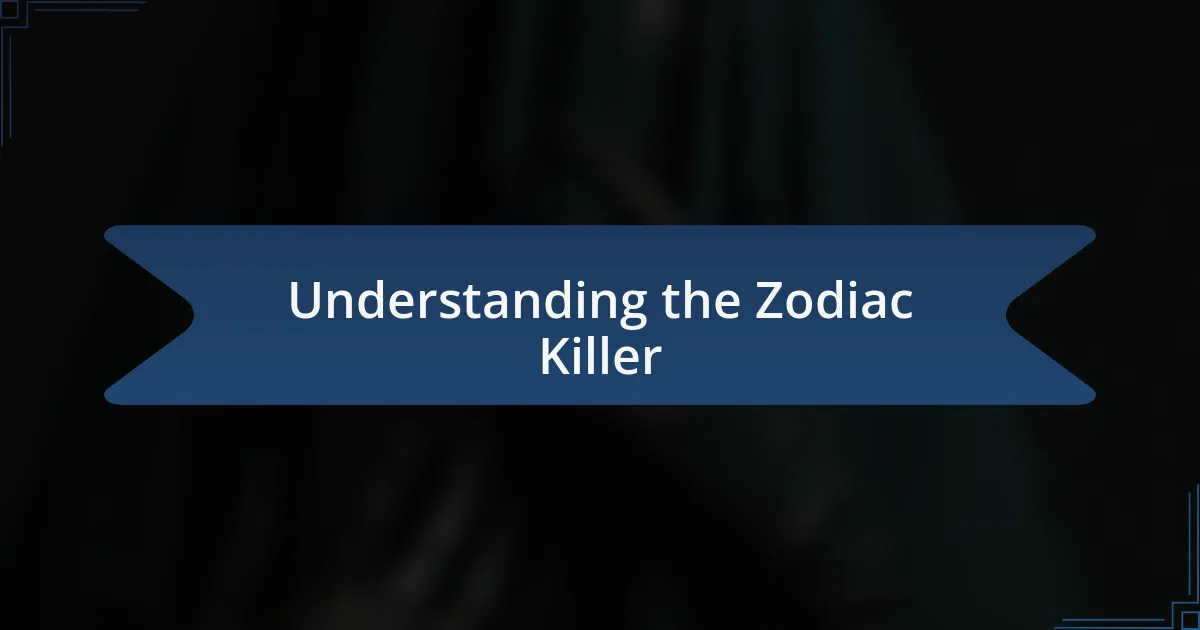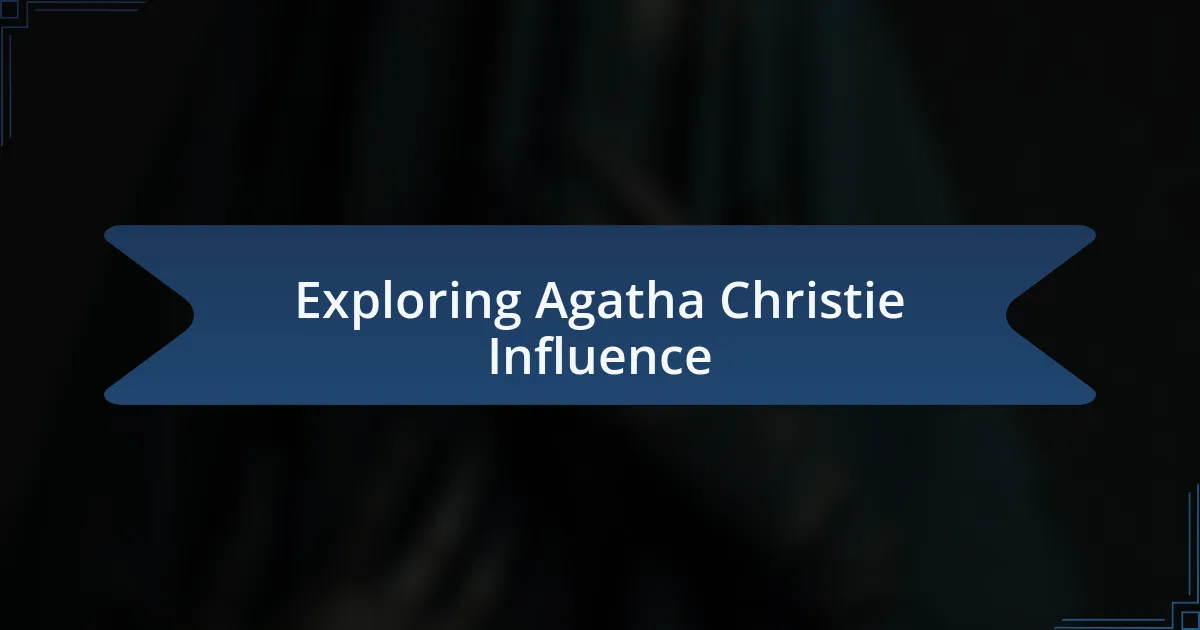Key takeaways:
- The Zodiac Killer’s psychological complexity and desire for notoriety highlight the darker aspects of human nature and societal fear.
- Agatha Christie’s influence on crime literature emphasizes the intricacies of human psychology, paralleling the manipulative tactics of real criminals like the Zodiac.
- The similarities between historical crime figures, such as the Zodiac and Jack the Ripper, reveal patterns of media manipulation and infamy associated with their actions.
- The Zodiac’s impact on criminal psychology and investigative techniques emphasizes the importance of understanding the motives behind heinous acts to prevent future tragedies.

Understanding the Zodiac Killer
The Zodiac Killer remains one of the most enigmatic figures in true crime history, leaving behind a trail of terror across Northern California in the late 1960s and early 1970s. I often find myself pondering what drove this individual to commit such horrific acts and then taunt the authorities with cryptic letters and ciphers. What kind of person finds satisfaction in instilling fear in entire communities?
What truly fascinates me is the killer’s ability to blend into the fabric of society while committing heinous crimes. As I read through the accounts of his interactions and the chilling puzzles he sent to newspapers, I can’t help but feel a mix of dread and intrigue. Each letter seemed to offer a glimpse into a disturbed mind, inviting the public into a dark game where human lives were mere pieces on a chessboard.
These aspects highlight the Zodiac’s psychological complexity and his craving for notoriety. I often wonder how impacted the survivors and families of the victims were by his actions. It’s not just a story of murder; it’s a haunting tale of fear that has lingered through the decades, prompting questions about justice, obsession, and the darker side of human nature. This ongoing mystery continues to captivate and terrify, leaving many—including myself—seeking answers that may never come.

Exploring Agatha Christie Influence
Agatha Christie’s influence on the crime genre is profound and undeniable. Her ability to craft intricate plots with clever twists has inspired countless authors, including those who delve into true crime. When I read her novels, I am always struck by how she weaves human psychology into her mysteries, much like the Zodiac Killer’s manipulative tactics—creating layers that unveil the darkest corners of the human psyche.
I recall the first time I read “Murder on the Orient Express.” Christie’s approach to character development made every suspect feel like a potential killer, engaging my intuition and sparking my curiosity. This mirrors the way the Zodiac played on public fears, turning ordinary people into pawns in a deadly game. Can we really know the mind of a murderer? Christie seemed to suggest that everyone carries secrets, and this notion resonates deeply as I reflect on the enigma of the Zodiac.
Her influence extends beyond mere storytelling; it reshapes how readers understand crime and motive. Each time I revisit Christie’s work, I’m reminded that beneath every façade lies a complex web of intentions, emotions, and past experiences. This connection between Christie’s fictional worlds and real-life horrors, like those orchestrated by the Zodiac, invites us to consider not just the acts themselves but the human stories behind them.

Comparing Historical Crime Figures
When I think about historical crime figures, it’s fascinating to consider how their methods and profiles can often mirror one another, despite the era they inhabited. Take the Zodiac Killer and Jack the Ripper, for example; both took advantage of their time’s social fears and showcased a certain bravado that left communities both terrified and enthralled. I often wonder if these criminals knew the chaos they sparked would endure far beyond their own actions.
The Zodiac’s meticulous taunting of law enforcement mirrors the cat-and-mouse game of Jack the Ripper, creating a chilling narrative that continues to captivate the public’s imagination. Each criminal, operating in their unique contexts, manipulated media attention in ways that created legends. This makes me question how much of their infamy stemmed from their heinous actions versus the publicity they received—did they crave notoriety, or was it simply a byproduct of their violence?
Moreover, considering figures like Ted Bundy or even more contemporary criminals, one can’t help but notice the patterns of charm and deceit. Their ability to blend into society adds layers of complexity to their horrifying tales, reminiscent of Christie’s characters who often reveal deeper, darker truths beneath their polished surfaces. It makes me reflect: how well do we truly understand the psyche of these individuals, and what drives their horrifying behaviors?
Analyzing Zodiac Killer’s Impact
The Zodiac Killer’s impact is profound, not just in the realm of crime, but in how it reshaped societal perceptions of safety. I remember when I first learned about the case; it struck me how quickly fear can spread through communities, permeating everyday life. The killer’s enigmatic personality, coupled with the cryptic letters sent to newspapers, turned him into a folk figure, and I can’t help but think—how does an individual wield that much influence over people’s fears?
Throughout the years, the Zodiac’s methods and his ability to evade capture inspired countless films, books, and documentaries. I often find myself contemplating whether this glorification serves to inform or sensationalize the truth of his heinous acts. For instance, it creates a strange allure that can overshadow the pain his victims and their families endured. Are we, as a society, sometimes more enamored with the myth than the reality?
Interestingly, the Zodiac case sparked discussions on criminal psychology and investigative techniques that continue to resonate with today’s law enforcement practices. I recall listening to a podcast that traced how modern profiling owes some of its foundations to studies of notorious figures like the Zodiac. This evolution makes me wonder if understanding the mind of such criminals can help prevent future tragedies. What if by dissecting their motives and actions, we unlock clues to deter future crimes?
Drawing Parallels to Christie’s Works
In Agatha Christie’s works, the theme of an enigmatic criminal often takes center stage, much like the Zodiac Killer himself. I recall reading “And Then There Were None,” where the unknown antagonist manipulates his victims from the shadows, evoking a similar blend of fear and fascination that the Zodiac inspired. Isn’t it intriguing how both figures—fictional and real—tap into our deepest anxieties, leaving us wrestling with questions about justice and morality?
Moreover, Christie’s intricate plot twists reflect a psychological depth that resonates with the way the Zodiac mystified investigators. When I pieced together clues in “Murder on the Orient Express,” I felt that same thrill of deduction that was mirrored in the desperate attempts of police to understand the Zodiac’s psyche. Doesn’t this connection between fiction and the often harsh realities of crime highlight the limits of human understanding when faced with true evil?
Ultimately, Christie’s portrayal of crime provides a framework that allows us to explore the darker corners of human nature. I remember discussing with friends how her stories can be seen as a way to make sense of chaos, much like how I feel when analyzing the Zodiac case. Could it be that, through the lens of Christie’s narrative style, we find comfort in trying to unravel these complex, unsettling tales of humanity gone awry?